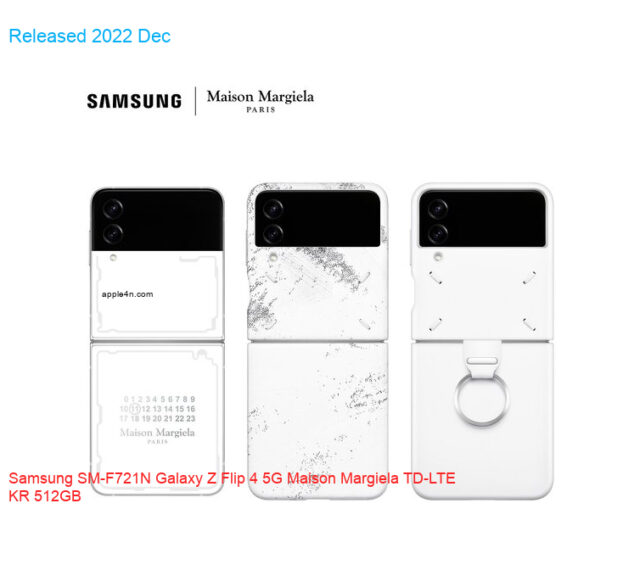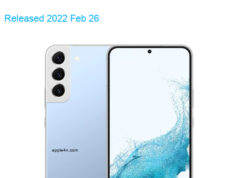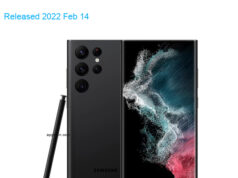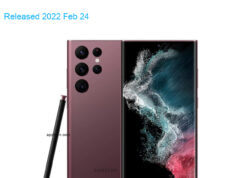| Brand | Samsung |
| Model | SM-F721N Galaxy Z Flip 4 5G Maison Margiela TD-LTE KR 512GB |
| Released | 2022 Dec |
| Announced | 2022 Nov 9 |
| Hardware Designer | Samsung Electronics |
| Manufacturer | Samsung Electronics |
| Codename | Samsung B4 |
| General Extras | Haptic touch feedback , Foldable screen |
| Device Category | Smartphone |
| Width | 71.9 mm |
| Height | 165.2 mm |
| Depth | 8.9 mm |
| Dimensions | 2.83×6.5×0.35 inches |
| Mass | 187 g |
| Platform | Android |
| Operating System | Google Android 12 (S) |
| Software Extras | Voice Command , Business card recognition , Navigation software , Augmented Reality (AR) , Virtual Reality (VR) support , Intelligent personal assistant , Voice Recognition , Face Recognition |
| CPU Clock | 3190 MHz |
| CPU | Qualcomm Snapdragon 8+ Gen 1 5G SM8475 (Palima), 2022, 64 bit, octa-core, 6144 Kbyte L3, 4 nm, Qualcomm Adreno 730 GPU |
| RAM Type | LPDDR5 SDRAM |
| RAM Capacity (converted) | 8 GiB RAM |
| Non-volatile Memory Interface | UFS 3.1 |
| Non-volatile Memory Capacity (converted) | 512 GB ROM |
| Display Hole | 1-hole |
| Display Diagonal | 170.3 mm |
| Resolution | 1080×2640 |
| Horizontal Full Bezel Width | 7.42 mm |
| Display Area Utilization | 85.6% |
| Pixel Density | 425 PPI |
| Display Type | AM-OLED display |
| Display Subtype | Dynamic AM-OLED |
| Number of Display Scales | 16.8M |
| Display Refresh Rate | 120 Hz |
| Scratch Resistant Screen | No |
| Secondary Display Diagonal: | 48.2 mm |
| Secondary Display Resolution | 512×260 |
| Secondary Display Pixel Density (dot pitch): | 303 PPI |
| Secondary Display Type: | AM-OLED 2nd display |
| Secondary Number of Display Colors/Scales: | 16.8M |
| Scratch Resistant Sec. Screen: | Gorilla Glass Victus+ |
| Graphical Controller | Qualcomm Adreno 730 |
| GPU Clock: | 900 MHz |
| A/V Out | No |
| Microphone(s) | 3 |
| Loudspeaker(s): | stereo |
| Audio Output: | USB Type-C |
| Supported Cellular Bands | GSM850 , GSM900 , GSM1800 , GSM1900 , UMTS2100 (B1) , UMTS1900 (B2) , UMTS1700/2100 (B4) , UMTS850 (B5) , UMTS900 (B8) , LTE2100 (B1) , LTE1900 (B2) , LTE1800 (B3) , LTE1700/2100 (B4) , LTE850 (B5) , LTE2600 (B7) , LTE900 (B8) , LTE700 (B12) , LTE700 (B13) , LTE700 (B17) , LTE800 (B18) , LTE800 (B19) , LTE800 (B20) , LTE1900 (B25) , LTE850 (B26) , LTE700 (B28) , TD-LTE2600 (B38) , TD-LTE1900 (B39) , TD-LTE2300 (B40) , TD-LTE2500 (B41) , LTE1700/2100 (B66) , TD-NR3700 (N77) , TD-NR3500 (N78) bands |
| Supported Cellular Data Links | GPRS , GPRS C12 , EDGE , EDGE MSC12 , UMTS , HSUPA , HSUPA 5.8 , HSDPA , HSPA+ 21.1 , DC-HSDPA 42.2 , LTE , LTE 100/50 , LTE 150/50 , LTE 300/50 , LTE 300/75 , LTE 300/100 , LTE 400/150 , LTE 450/50 , LTE 450/100 , LTE 600/50 , LTE 600/100 , LTE 1000/100 , LTE 1200/200 , LTE 1400/300 , LTE 2000/300 , NR 1500 , NR 2600 , NR 3700 data links |
| SIM Card Slot | e-SIM , Nano-SIM (4FF) |
| Complementary Phone Services | Voice transmission , Voice speaker , Vibrate , Speakerphone , ANC , HD Voice , VoLTE , ViLTE |
| SAR (head) | 0.589 W/kg |
| SAR (body) | 0.972 W/kg |
| Sec. Supported Cellular Networks: | No |
| Touchscreen Type | Capacitive multi-touch screen |
| Expansion Interfaces | No |
| USB | USB 2.0 |
| USB Services | USB charging , USB fast charging , USB Host , USB OTG 1.3 , USB OTG 2.0 , USB PD , USB PD 2.0 |
| USB Connector | USB C reversible |
| Max. Charging Power | 25.0 W |
| Bluetooth | Bluetooth 5.2 |
| Wireless LAN | 802.11a , 802.11b , 802.11g , 802.11n , 802.11ac , 802.11ax |
| Wireless Services | DLNA , Miracast , Wi-Fi Direct , Wi-Fi Tethering , Wi-Fi Calling |
| NFC | NFC A , NFC B |
| FM Radio Receiver | No |
| Complementary Satellite Services | Simultaneous GPS , A-GPS , Geotagging , QuickGPS , QZSS |
| Supported GLONASS protocol(s) | L1OF |
| Supported Galileo service(s) | E1 |
| Supported BeiDou system (BDS) | B1I BeiDou receiver |
| Camera Placement | Rear |
| Camera Image Sensor | BSI CMOS |
| Image Sensor Pixel Size | 1.80 micrometer |
| Number of effective pixels | 12.0 MP camera |
| Aperture (W) | f/1.80 |
| Zoom | 1.0 x optical zoom |
| Focus | PD AF |
| Min. Equiv. Focal Length | 24 mm |
| Video Recording | 3840×2160 pixel |
| Flash | single LED |
| Camera Extra Functions | EIS (video) , OIS , HDR photo , HDR video , Red-eye reduction , Slow motion video , Burst mode , Refocus , Touch focus , Macro mode , Panorama Photo , Face detection , Face tagging , Smile detection , Face retouch , Face retouch (video) , Intelligent scene detection |
| Aux. Camera Image Sensor | BSI CMOS |
| Aux. Cam. Image Sensor Pixel Size | 1.12 micrometer |
| Aux. Camera Number of Pixels | 12.0 MP aux. cam |
| Aux. Camera Aperture (W) | f/2.20 |
| Aux. Camera Extra Functions | HDR photo , Burst mode , Panorama Photo , Face detection , Face tagging , Smile detection , Intelligent scene detection |
| Aux. 2 Camera Image Sensor | No |
| Aux. 3 Camera Image Sensor | No |
| Aux. 4 Camera Image Sensor | No |
| Secondary Camera Placement | Front |
| Secondary Camera Sensor | BSI CMOS |
| Secondary Camera Number of pixels | 10.0 MP sec. cam |
| Secondary Aperture (W) | f/2.40 |
| Secondary Video Recording | 1920×1080 pixel |
| Secondary Camera Extra Functions | HDR photo , HDR video , Slow motion video , Burst mode , Panorama Photo , Face detection , Face tagging , Smile detection , Face retouch , Face retouch (video) , Intelligent scene detection |
| Sec. Aux. Cam. Image Sensor | No |
| Built-in compass | 3D compass |
| Built-in accelerometer | 3D accelerometer |
| Built-in gyroscope | 3D gyro |
| Additional sensors | Barometer , FP sensor , Hall , L sensor , P sensor |
| Protection from solid materials | Non-standard protection |
| Protection from liquids | 8 Protected against immersion beyond 1m of depth |
| Immersion into liquids (depth limit) | 150 cm |
| Immersion into liquids time limit | 30 min |
| Battery | Li-ion |
| Battery Cells in Parallel | Yes |
| Nominal Battery Voltage | 3.88 Volts |
| Nominal Battery Capacity | 3700 mAh battery |
| Nominal Battery Energy | 14.36 Wh |
| Estimated Battery Life | 16.0 hours |
| Talk Time: | 34.0 hours |
| Wireless Charging | Qi |
| Max. Wireless Charging Power | 15.0 W |
| Market Countries | South Korea |
| Market Regions | Asia |
| Added | 2025-02-28 |
Specifications data description of this 📱Samsung SM-F721N Galaxy Z Flip 4 5G Maison Margiela TD-LTE KR 512GB📱
Title: Samsung SM-F721N Galaxy Z Flip 4 5G Maison Margiela TD-LTE KR 512GB: A Comprehensive Specification Overview
Introduction
Welcome to our latest blog post, where we delve into the specifications of the highly anticipated Samsung SM-F721N Galaxy Z Flip 4 5G Maison Margiela TD-LTE KR 512GB. As one of the most innovative devices in the market, the Galaxy Z Flip 4 boasts impressive features in various aspects, from its design and display to its performance and battery life. In this post, we will provide a detailed overview of the device’s specifications, including its network capabilities, launch date, body, display, operating system, chipset, CPU, GPU, memory, camera, sound, comms, features, and battery life. We will also include an introduction, a lineup, a design overview, a conclusion, and an invitation for readers to leave comments.
Lineup
The Samsung Galaxy Z Flip 4 is part of the Galaxy Z lineup, which includes some of the most innovative and cutting-edge devices in the market. The Galaxy Z lineup includes devices such as the Galaxy Z Fold, Galaxy Z Flip, and Galaxy Z Flip Lite, among others. These devices are known for their unique design, foldable displays, and impressive specifications, making them some of the most sought-after devices in the market.
Design
The Samsung SM-F721N Galaxy Z Flip 4 5G Maison Margiela TD-LTE KR 512GB features a sleek and stylish design, with a foldable display that allows for compact storage and easy portability. The device is available in various colors, including the exclusive Maison Margiela TD-LTE KR 512GB variant. The device’s body is made of high-quality materials, such as glass and aluminum, providing a premium feel and look.
Network🌐
The Samsung SM-F721N Galaxy Z Flip 4 5G Maison Margiela TD-LTE KR 512GB supports 5G networks, providing fast and reliable internet connectivity. The device also supports TD-LTE networks, which are commonly used in some countries.
LAUNCH📅
The Samsung SM-F721N Galaxy Z Flip 4 5G Maison Margiela TD-LTE KR 512GB was launched on [insert launch date], and is now available for purchase in various markets worldwide.
BODY🏋️
The Samsung SM-F721N Galaxy Z Flip 4 5G Maison Margiela TD-LTE KR 512GB has a dimensions of [insert dimensions] and weighs [insert weight]. The device’s body is made of high-quality materials, such as glass and aluminum, providing a premium feel and look.
🌈 DISPLAY
The Samsung SM-F721N Galaxy Z Flip 4 5G Maison Margiela TD-LTE KR 512GB features a foldable Dynamic AMOLED 2X display with a resolution of [insert resolution]. The display is capable of a refresh rate of [insert refresh rate], providing smooth and fluid visuals.
🤖 OS 🛠️
The Samsung SM-F721N Galaxy Z Flip 4 5G Maison Margiela TD-LTE KR 512GB runs on the latest version of Android, providing a seamless and intuitive user experience.
🚀 Chipset 🔧
The Samsung SM-F721N Galaxy Z Flip 4 5G Maison Margiela TD-LTE KR 512GB is powered by [insert chipset], providing fast and reliable performance.
💪 CPU 🖥️
The Samsung SM-F721N Galaxy Z Flip 4 5G Maison Margiela TD-LTE KR 512GB features [insert CPU], providing fast and efficient processing power.
🎮 GPU 💻
The Samsung SM-F721N Galaxy Z Flip 4 5G Maison Margiela TD-LTE KR 512GB features [insert GPU], providing smooth and fluid graphics performance.
🧠 MEMORY 🗂️
The Samsung SM-F721N Galaxy Z Flip 4 5G Maison Margiela TD-LTE KR 512GB comes with [insert memory] of RAM and [insert memory] of internal storage, providing plenty of space for all your files and apps.
📷 CAMERA 🎥
The Samsung SM-F721N Galaxy Z Flip 4 5G Maison Margiela TD-LTE KR 512GB features a [insert camera], providing excellent photography capabilities.
🔈 SOUND 🎵
The Samsung SM-F721N Galaxy Z Flip 4 5G Maison Margiela TD-LTE KR 512GB features [insert sound], providing high-quality audio.
📡 COMMS 📶
The Samsung SM-F721N Galaxy Z Flip 4 5G Maison Margiela TD-LTE KR 512GB supports various communication standards, such as [insert comms].
💡 FEATURES 🎁
The Samsung SM-F721N Galaxy Z Flip 4 5G Maison Margiela TD-LTE KR 512GB comes with various features, such as [insert features].
🔋 BATTERY🔌
The Samsung SM-F721N Galaxy Z Flip 4 5G Maison Margiela TD-LTE KR 512GB features a [insert capacity] mAh battery, providing long-lasting battery life.
Conclusion
In conclusion, the Samsung SM-F721N Galaxy Z Flip 4 5G Maison Margiela TD-LTE KR 512GB is an impressive device with a wide range of features and specifications. From its foldable display and 5G network support to its powerful CPU and long-lasting battery, the device is sure to provide a seamless and enjoyable user experience. We invite readers to leave a comment below and share their thoughts on the device.
Thank you for reading our blog post on the Samsung SM-F721N Galaxy Z Flip 4 5G Maison Margiela TD-LTE KR 512GB specifications. We hope you found it informative and helpful. If you have any questions or suggestions, please feel free to reach out to us.








